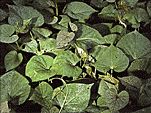Ipomoea batatas
Sweet potato, Camote
Tropical/Sub-tropical

Introduction
Sweet potatoes are considered to be somewhere between the sixth and the ninth most important food crop in the world. Thought to originate in southern Mexico, Central America and possibly the West Indies, sweet potato culture has spread throughout the tropics and much of the world's warmer temperate zone. It has been theorized that the extremely hard coat of the sweet potato seed enabled it to remain viable floating on the long passage from the coast of Central America to the islands of the South Pacific.
Sweet potato is a true 'poor man's crop', with most of the production done on a small or subsistence level. It is well suited to survive infertile tropical soils and to produce for farmers without fertilizers, irrigation, machinery or improved propagation stock. Sweet potato is an excellent dual-purpose food crop because its leaves are nutritious and are widely eaten. Though often grown as an annual, sweet potatoes are a perennial vine that can produce edible tubers and leaves for up to six years without replanting in tropical climates. In a system where the both the leaves and tubers are well managed for good yield, sweet potatoes can probably produce more nutrients per acre than any other crop, including more calories per acre than cassava. They have one of the highest returns of nutrients, relative to the time and effort expended, of any crop.
Although it is already one of the world's leading food crops, sweet potatoes have enormous potential that remains to be tapped. Its importance will likely increase as systems are developed to maximize combined leaf and tuber yield. Genetic research on varieties that are high yielding (up to 60 tons per hectare), pest resistant, and starchy tasting like Irish potato rather than sweet, could put sweet potatoes at the center of the effort to feed the huge populations of the tropics in the near future.
Pros
- Sweet potato leaves are especially rich in calcium.
- The average yield of cassava roots worldwide is 9,600 kg to the hectare, whereas the average yield of sweet potato tubers worldwide is 13,900 kg to the hectare.
- Sweet potato vines and tubers make good animal feed. The tubers have far more protein and beta-carotene than cassava, and have relatively little of the cyanogenic glycosides that limit cassava's value.
- They can be planted very densely to choke out perennial grasses and nutsedges that are otherwise very difficult to eradicate. If some of the leaves are used as food this could be an inexpensive and productive alternative to herbicides.
Cons
- Leaf and stem diseases and rot are a problem especially in areas of very high humidity and stagnant air.
- Very cold sensitive
- While not usually a problem, some varieties of sweet potatoes have hydrocyanic acid (HCN) in their leaves. As a precaution, sweet potato leaves should be boiled and the water discarded.
- Sweet potatoes must be cooked to destroy protease inhibitors. These are substances also found in beans, cowpeas, and soybeans that limit growth by blocking the usefulness of enzymes that aid in the digestion of proteins.
Notes
- The size and shape of the leaves also vary widely among different cultivars. At least 15 different leaf types are known.
- The type of cultivar determines the age at which sweet potatoes should be harvested. Some cultivars can be harvested 90 days after planting. Other cultivars may require as long as 350 days.
- In many countries, tubers are usually harvested progressively as they develop and as they are needed.
- In most countries, sweet potato tubers are used mainly as a human food. Only small amounts are used for animal feeding.
- Leaves are normally ready for harvest by 40 days after planting. The young leaves can be harvested from then on as long as a significant proportion of fully developed leaves are left on the plant.
- Those parts of West Africa that have a tradition of eating sweet potato leaves cooked in palm oil, despite having few animal products in the diet, have a far lower incidence of nutritional deficiency diseases than neighboring cultures that scorn the leaves as ' animal food".
- In Sierra Leone farmers grow selected varieties that favor production of big tender leaves over tubers. This accounts for sweet potato leaves becoming one of the most important leaf vegetables in that country.
- In contrast to other roots and tubers, sweet potatoes are normally sweet after cooking because they contain the enzyme amylase, which converts starch into sugars at high temperatures. During an hour of baking, the sugar content may increase from 10 or 12 % to over 45 %, of which maltose is the most important.
- Kang kong (Ipomea aquatica) is a closely related vegetable grown only for its edible foliage. It is a very popular green throughout much of Southeast Asia, but has not caught on well in other areas. It is most often grown as a paddy of wetland crop, though upland varieties have been developed. It is illegal to introduce in some places because of its potential as a water weed.
- In the Philippines sweet potatoes are sometimes grown in a complex but stable system with alnus and coffee trees.
Seeds
- Normally propagated from slips or small plants started from the previous year's tubers or purchased locally. Many garden and farm supply stores and some mail order seed houses carry sweet potato slips.
Related Plants with Edible Leaves
Ipomoea aquatica or I. Reptans (kang kong or water spinach)